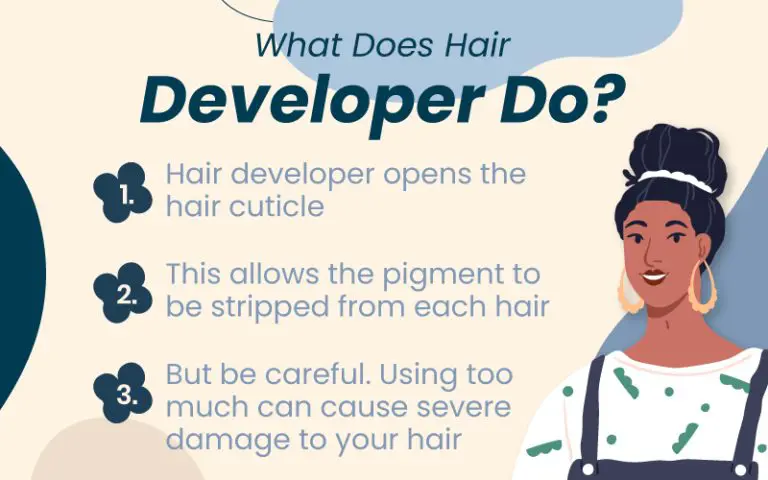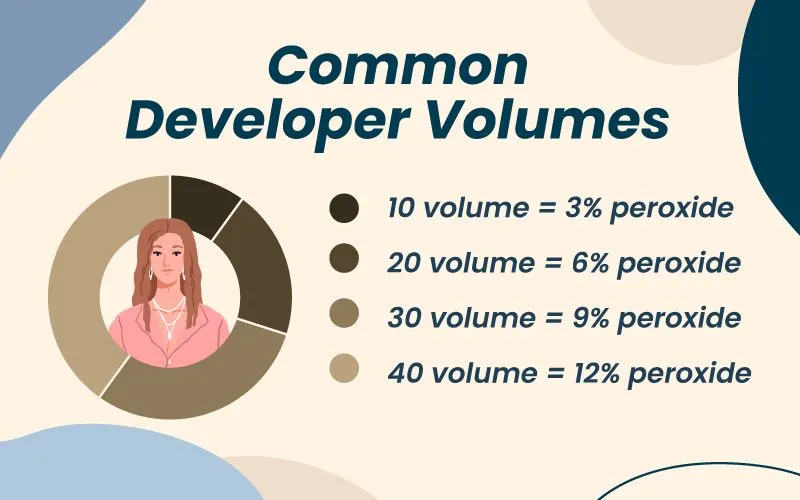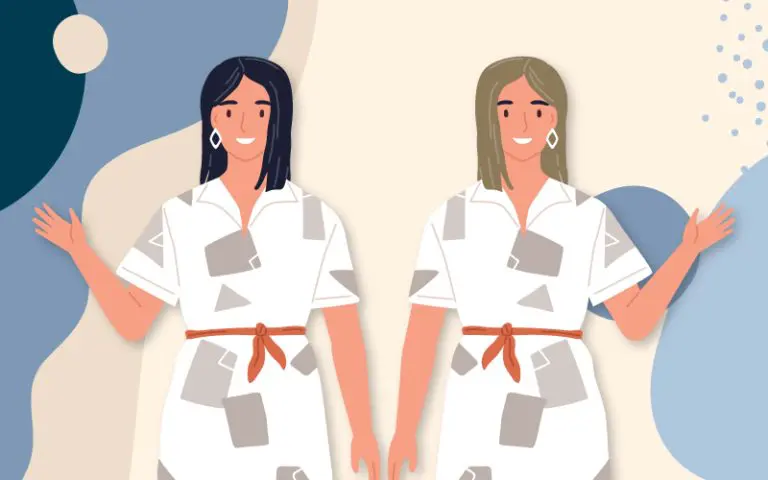Jump to:
When bleaching or dying your hair at home, it’s essential to use the right developer. With so many different options for home hairstylists, it’s crucial to choose the right one for your hair. Read on to find out what developer you should use.
What Is Hair Developer?

Hair developers are essential to any bleach or dye job because they allow the bleach or dye to penetrate the hair shaft. They are called activators because they lift the cuticle of the hair shaft.
Instead of just sitting on top of each strand, the color or bleach permanently changes the hair. Without developers, hair dye would not work. If you use too low of a developer, you will not get the result you are looking for.
That brassy-orange look of a bad bleach job is usually because of a low-volume developer. You also do not want to use too high of a developer, or you can seriously damage your hair. Developers come in a variety of volumes to choose from.
Typically, you will find developers in 10, 20, 30, or sometimes 40. These volumes refer to how much the product will oxidize and therefore lift the cuticle of the hair shaft. For stronger or higher volume, the developer will lift the cuticle more.
What Developer Should You Use?

Choosing the right developer is a delicate game of balancing getting your desired results and not damaging your hair. Because all developers open the hair cuticle, they all cause damage.
Minimize damage to your hair by always choosing the lowest volume developer that will give you your desired suits. Sometimes, your boxed hair dye comes with a developer, but it is better to buy them separately.
It allows you to choose the right developer for your hair and desired results. Each volume of developer has a specific situation where it is the best choice. The most common and available hair developers are:
Volume 10 Hair Developer
Use volume 10 developer if you want to change the tone or tint of your hair color. Because it’s the lowest strength developer, it will not lift your current color. That means any dye you are adding will not be able to penetrate the hair cuticle enough to change the color completely.
If you have brown hair and you’re looking to add a rosier tint, volume 10 is the perfect choice for a developer. A volume 10 developer with a pinkish-red dye will work beautifully if you want a strawberry blonde look.
If you’re looking to go from light brown to black or black to blonde, volume 10 is not nearly strong enough. Even for blondes wanting natural-looking highlights, volume 10 does not lift enough to lighten their hair.
The best way to use volume 10 developer is with hair toners. A volume 10 developer with a blue toner will do the job if you have a brassy tinge to your bleached hair. If your hair is more yellow than blonde, combine a volume 10 developer with purple toner to balance it.
Volume 20 Hair Developer
Volume 20 is the Goldilocks of hair developers; it’s not too strong and not too weak. It will lift your hair color one or two levels, which means it’s excellent as a gentler option for permanent hair dyes.
For natural blondes looking for a more sun-bleached look, using volume 20 developer with bleach will help you achieve that look. Be sure to mix with a purple toner to keep your hair a cool ash blonde.
Also, wash your hair with purple shampoo to continually tone it. For anyone looking to cover grays, a volume 20 developer with your permanent hair dye of choice will provide full coverage without a lot of breakages.
It’s also an excellent option for people with minimum hair damage to explore bolder colors. If you want a bright blue or bright pink hair job, a volume 20 developer will strip enough of your natural pigment to give you that fully pigmented result you’re looking for.
Volume 20 developer is a great all-around choice if you’re looking to change up your look a little. However, it’s not strong enough to go from dark brown to blonde.
Volume 30 Hair Developer
For those looking for a more obvious change, a volume 30 developer allows you to lift two or three levels and penetrate the hair shaft deeper for a more pigmented result. Volume 30 developer with bleach will lighten medium brown hair to blonde very well.
Whenever you’re lightening hair that much, it’s essential to use hair toner to avoid a brassy outcome. If you find that your hair is too low porosity to take to hair dye, volume 30 is also an excellent choice for a developer.
It can be better than the lower volume developers, leaving your hair shafts open to the dye. The best way to get to blonde is by using volume 30 developer with bleach for people with dark brown or even black hair.
It will not be strong enough to get you to bleach blonde after one use, so plan to use it multiple times with plenty of TLC for your hair in between bleaching sessions. Use the combination of volume 30 developer, bleach, and toner until you get your desired result.
Volume 40 Hair Developer
Volume 40 developer should be used extremely carefully. It is 12% peroxide, meaning it can burn your scalp if you have sensitive skin or leave it on for too long. With that stated, volume 40 developer is useful in certain cases.
It will lift your hair color up to 4 levels on its own. You can use it without bleach to achieve highlights. Volume 40 is also the go-to developer if you’re looking to go from dark brown or black hair to light brown or blonde.
Again, always use toners when bleaching brown hair to avoid an orange tint. Volume 40 developers should be left to the professionals because of their strength and potential to cause severe burns.
If you want the results of a volume 40 developer at home, it is better to use a volume 20 or 30 developer multiple times. Between rounds of lightening, be sure to use conditioning treatments and bond builders to avoid over-damaging your hair.
What to Keep in Mind When Using Developer
While you can safely use a developer at home, it is essential to keep a few things in mind. These tips will keep your hair looking and feeling great, and they’re easier than you might expect.
Take Care of Your Hair
When using a developer, you will cause some damage to your hair no matter what. That is why it is essential to take care of your hair before, during, and after applying a developer to your hair.
Using a developer with bleach is particularly damaging, so spoil your hair with specially-made conditioning treatments and hair masks. Hydration is essential for your scalp and hair follicles, so be sure to keep it hydrated.
Remember to Use Toner
Anytime you take your hair from dark to light, it is necessary to use toner. This will help you avoid brassiness in your hair. Using a purple toner will avoid a yellow tint to your hair, while blue toner will avoid an orange tint.
Going from brown to blonde most commonly causes an orange tint, so blue toners are crucial for brunettes looking to go blonde. Toners also have the added benefit of adding gloss and shine to dyed hair.
Sometimes bleach can leave hair feeling and looking dull, so toner is a great two-for-one to counteract brassiness and dullness. If you’ve had enough chemicals in your hair, you can also use some household products to help tone your dye job.
Apple cider vinegar and lemon juice will more powerfully tone your hair, but be aware of leaving it on too long as that can damage it too. For a gentler, at-home tone, use different types of tea like green, hibiscus, or chamomile.
Frequently Asked Questions

It is challenging to understand when to use bleach, toners, developers, and other hair-dying products to achieve the look you want, but you’ll get an excellent, stress-free hairstyle once you know what works best for your hair.
Check out the quick answers below if you still have questions about how to find the correct toner for your hair color and texture and apply it properly without causing damage.
What developer should I use to bleach my hair?
The best developer to use with bleach is volume 20 or 30, depending on your current hair color and hair porosity. If you have light brown or super porous hair, use volume 20 developer.
If you have dark brown or low porosity hair, use volume 30 developer. If you have naturally blonde hair that is already damaged, you can use volume 10.
What developer should I use to go darker?
The best developer to use to darken hair is volume 20. Volume 30 and 40 will lift your hair color significantly, so the dye will not be as dark. If you already have dark hair, you can also use volume 20 developer to minimize damage.
What developer should I use for bright red hair?
For a bold, bright red result, volume 20 developer is your best bet. A volume 30 or 40 will lighten your hair too much to leave your hair bold and pigmented. A volume 10 will not lift your color enough to fully dye your hair red.
What developer should I use with toner?
You can use all developers with toner. You should always use toner when lightening hair to avoid a brassy result.
If you already have a brassy tint to your bleached hair, using volume 10 developer with a blue toner will cool down your tone. If your hair has a more yellow tint, use a purple toner to counteract it.
What developer should I use for dark hair?
If you have dark hair and are looking to go darker, use a volume 10 with your dye. If you’re looking to lighten your hair one or two levels, use volume 20.
For 2-3 shades lighter, use a volume 30 developer. Volume 40 developers should only be used by professionals to take the darkest hair down to blonde.
So, How Do You Know What Developer to Use?
If you’re going for a subtle change, a volume 10 developer will minimize damage and still provide your desired results. Volume 20 is an excellent choice for most jobs, including gray coverage, bold hair colors, and light bleach jobs.
Volume 30 is for taking dark hair to light through multiple processes until you end up with a shade you’re happy with, and volume 40 should be used by professionals and only in certain cases.
